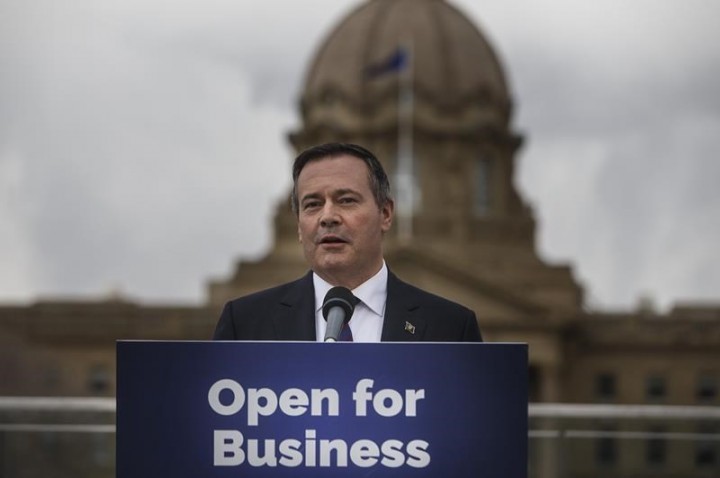EDMONTON — Alberta Premier Jason Kenney, at the founding convention of his United Conservative Party in 2018, said he’d consider members’ input on policy but the bottom line was simple: “I hold the pen.”
Four years later, the membership took back the pen and made it clear to the driving force behind the reunification of conservatives in Alberta that the writing was on the wall and it was time for him to go.
Jason Kenney, the province’s 18th premier, told a shocked audience of invited guests and cabinet ministers Wednesday that 51 per cent support of party rank and file in his leadership review was not enough to quell internal dissension wracking his party.
He announced he would resign from the top job, saying that while his team had accomplished many things, a lack of unity put it all in jeopardy.
“We reunited the free enterprise movement in Alberta politics, and we won the largest electoral mandate in our province’s history,” said Kenney.
“We inherited profound fiscal and economic challenges. And then we went through three once in a century crises: the largest public health crisis in a century, the largest collapse of the world economy in nearly a century and for the first time ever we experienced negative oil prices.
“Despite all of that we got the job done.”
In his three years as premier, Kenney steered the province through the COVID-19 pandemic while seeking to expand the oil and gas sector, further diversify the economy and remake the public health system. On the strength of soaring oil and gas prices, he balanced the budget for the first time in years.
His trademark was bulldog willpower combined with work ethic and tenacity few could match.
His days often began early with a news conference, then meetings, question period, a speech in the house, party events, fundraisers and more phone calls long into the evening. There were Facebook townhalls and a radio show.
It was a brash, combative populist style that often sought to rally support by dividing Albertans against opponents, both real and perceived.
His favourite target was Prime Minister Justin Trudeau’s federal government. He blamed it for hamstringing the oil and gas industry through punitive legislation and a consumer carbon tax, but often ignored the fact Ottawa was paying the freight on the TransMountain pipeline to the B.C. coast.
He once publicly dismissed Trudeau as an “empty trust-fund millionaire who has the political depth of a finger bowl.” He characterized a pipeline-opposing U.S. governor as “brain dead.”
He picked fights with doctors, tearing up their master agreement just as the pandemic hit in full force in 2020. His government also tried to cut nurses’ wages.
He decried the folly of fixing the economy by “picking winners and losers” through targeted investments, only to lose $1.3 billion trying to revive the transcontinental Keystone XL pipeline.
His government fought with the Alberta Teachers’ Association and is still implementing a controversial school curriculum that almost all school boards have refused to test drive.
He created a so-called energy war room designed to fight with oil and gas foes. Instead, it stumbled through a series of gaffes, including a public fight with a children’s cartoon about Bigfoot.
His leadership, particularly during the pandemic, exposed contradictions that contributed to low poll ratings even as the economy started bouncing back.
He called for civility in public debate and then handed out earplugs in the house so his members wouldn’t have to listen to the Opposition NDP.
During COVID-19, Kenney tried to steer the province through the middle course, waiting until the last moment — as hospitals were reaching dangerous capacity — before imposing new health restrictions.
When the province reached dangerous levels last fall, to the point that patient triage might have been necessary, he accepted responsibility for not acting and then said he would have acted if the chief medical health officer had recommended it.
When he took over the health system, he blamed the former NDP government for problems he inherited. In recent weeks, as the system has continued to strain under COVID-19, he blamed Alberta Health Services, the front-line care provider.
The end came not from outside but from inside the caucus.
Backbenchers said Kenney had promised to bring them around the decision-making table but instead froze them out. Decisions, they said, were made by Kenney and a clutch of close advisers. Some dissenters found themselves kicked out of caucus.
With Kenney there was controversy. Always controversy.
He defeated Brian Jean in the inaugural 2017 party leadership race. It was later learned his team colluded with another candidate to try to scupper Jean’s chances. Kenney has said he didn’t know anything about it.
When the election commissioner investigated possible wrongdoing in that race, Kenney’s government, while he was away in Texas, introduced and passed a law to fire him. The RCMP continues to investigate allegations of voter identity fraud in that race.
This year, when Kenney’s justice minister, Kaycee Madu, was found to have tried to interfere in the administration of justice by calling Edmonton’s police chief to argue about a traffic ticket, Kenney simply moved him to another cabinet job.
Kenney, 53, has spent much of his adult life in the public eye, famous for saying he can’t help but march to the sound of rhetorical gunfire.
He has fought for conservative principles and the concept of ordered liberty, first as an anti-tax crusader and later as a key lieutenant in former prime minister Stephen Harper’s cabinet in portfolios that included immigration, employment and defence.
He is a Catholic and has spoken out against gay marriage and abortion in the past, but didn’t wade in on those issues as premier.
He is known for his drive, populist instincts and a nose for the political jugular.
To win the UCP leadership, he drove back and forth across Alberta in a blue pickup truck to meet and greet thousands of supporters and fence-sitters. In less than two years, he got 87 constituency associations and candidates running.
The blue pickup truck has become part of his persona.
Perhaps in a harbinger of what was to come, Kenney recently had that same truck at a news conference to announce a cut in gas taxes.
As the cameras rolled, Kenney filled up his tank, then pulled, yanked, yanked and yanked — at one point using two hands — in a failed attempt to pull out the hose.
Finally, he gave up, turned and looked sheepishly at the crowd.
The pickup was stuck.
And this time, there was no one to blame.
This report by The Canadian Press was first published May 18, 2022.
Dean Bennett, The Canadian Press
Related


































